A Shopper’s Guide to Urban Catastrophe
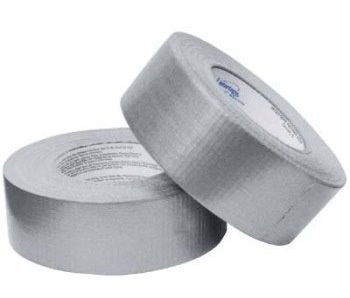
Exactly one hundred years ago to the day a "large horizontal displacement" along the San Andreas Fault devastated the city of San Francisco. In the century since then, hurricanes have battered Miami, levees have failed New Orleans, airplanes have become Weapons of Mass Destruction, and "prodigious snowfall combined with drenching spring rains" has conspired to wreak havoc on Grand Forks, North Dakota.
American urban catastrophe, in other words, is everywhere.
This post-disaster urban world – with no police, no public utilities, no clean drinking water, and, potentially, no hope – is something you can prepare for, however, by shopping.
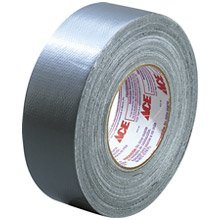
In February 2003, Homeland Security’s then-chief Tom Ridge made life far simpler for Americans everywhere by unveiling a national catastrophe shopping list – at the top of which was duct tape.
"Stash away the duct tape!" said Ridge, and millions did just that. It didn't matter that duct tape was widely alleged to be ineffective in the face of biological and chemical attack (or that Ridge later withdrew his own advice, complaining that there had been "some political belittling of duct tape"); the silver rolls flew right off the shelves, salving (or stoking?) the anxieties of a traumatized nation.
The rest of Ridge's shopping list – Recommended Items to Include in a Basic Emergency Supply Kit – compares favorably with many other shopping lists or pre-packaged kits I came across in my urban catastrophe shopping reconnaissance. I was particularly impressed by the inclusion of eating utensils (a common omission), along with a wrench or pair of pliers to turn off any dangerous utilities.
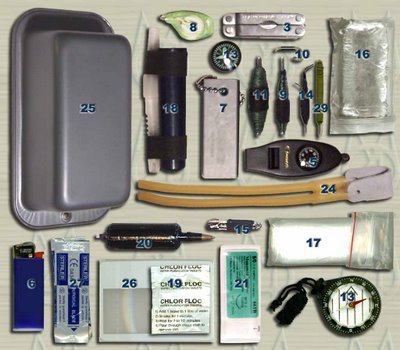
The rest of the basics are predictable and quite consistent from list to list: water, whistle, can opener, first aid kit, copies of important documents, sleeping bags or warm blankets, waterproof matches, etc. The only thing missing is a Paul Oakenfold CD.
Indeed, the core contents of catastrophe survival kits have barely changed since World War I, and, as such, allow little room for personal expression. However, all of the lists do recommend storing at least 72 hours' worth of food – and food customization is a field of endless opportunity.
There are several things to bear in mind whilst considering what food you should buy to prepare for urban armageddon. Food should be relatively non-perishable (and you should remember to replace it before it expires), require little or no cooking, and be low-sodium so as not to provoke chronic thirst. Canned foods, powdered and instant foods, jerky and peanut butter are standards on the "do-it-yourself" list, with instant soup cups described as a "real boon."
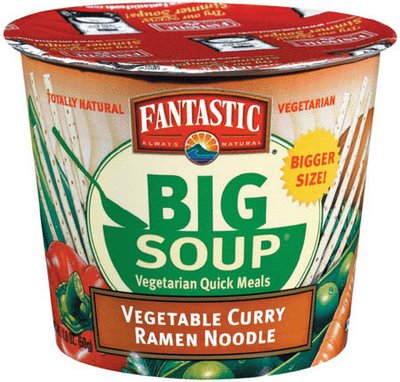
Vegans and Atkins-aficionados, as usual, will find their choices more limited. In a CarbSmart article entitled "A New Day and New Priorities: Being Prepared For The Unforeseen," Di Bauer recommends that low-carbers stock up on canned clams (her suggestion: "bread" them with unflavored protein powder), Ragu Double Cheddar Sauce, diet soda, and an intriguing product called not/Starch. ("If the world ends, I am going to be buried with my not/Starch").
Vegans, of course, seem to be understandably concerned with post-catastrophe protein sources – but, from what I've read, they also seem to have a good handle on the cunning you'll need to survive urban collapse, suggesting "treats for bargaining," as well as "a small bottle of spirits," because "sometimes it's just what you – or others – need." (It can also be used "as an antiseptic").
In the run-up to Y2K, Carol Reid authored the delightfully-titled, Catastrophic Cooking: Eating Right When All Is Wrong, in which she shares the secret of her "Cardboard Box Oven," which was "designed by an Aerospace Engineer" and "will bake everything from bread to pizza at temperatures up to 475 degrees." The book is now out-of-print.
Thinking outside the box – or the can – one Bay Area architecture and design student recommends growing your own emergency garden: she’s "planting a high-density orchard this winter, with varieties timed to ripen sequentially all year rather than all at once in July." Let’s hope a rather frightening man called The Everlasting Phelps doesn’t figure out where she lives, because his "plan is a little more simple. I have guns, ammo, and armor, and I plan to loot."
At specialized sites such as TheEpicenter.com or Earth Shakes ("Are you prepared? Wait no longer!"), online shoppers are offered a choice between 3600-calorie, "pleasant tasting, shortbread cookie-like" foodbars, "6 Can Food Modules," "10 Year Super Vitamins," bags of "Survival Candy," and Heater Meals.

Duct tape, food, and water are the first things the urban catastrophe shopper might purchase – but if the New Orleans Superdome taught us anything, it is the paramount importance of sanitation provision.
This is an area best left to the professionals, and Earth Shakes seems to have covered all the bases: it offers a PETT, WAG BAGS, PUP, and TOTE ensemble. These are, respectively: a Portable Environmental Toilet, "weighing only 7lbs, yet the same height as a standard toilet"; Waste Alleviation and Gelling bags containing "Pooh Powder" (a unique product that "gels liquids, catalyzes decay, and removes odor"); Portable Utility Pop-up tent (to ensure privacy); and a TOTE backpack with which to carry everything around.
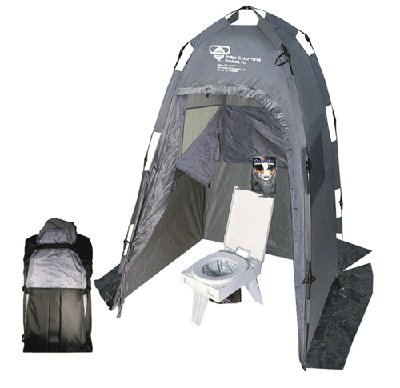
Assuming you can find and lift a manhole cover in the midst of catastrophe, the Japanese have even developed a WAG BAG-free option. You are instructed to install it immediately above a (hopefully still intact) municipal sewer system – then relax...
I’d also like to draw your attention to the "Shower in a Bag" – ("No rinsing needed. Microwaveable too!") – and, for the shy or hijab-wearing, a "Deluxe Privacy & Shower Room." Truly, all the comforts of home.
Meanwhile, if money's no object, there's the "disaster kit of the future." With this, CNET staff writer Stefanie Olsen introduces us to Seldon Laboratories' "nano mesh," which can be fabricated into a "waterstick," allowing fortunate survivors to "suck ditch water like they would using a straw in a glass of water." Another membrane technology works by fluid osmosis, with one side flavored "so it can turn dirty puddle water into Gatorade."
Other tech-savvy toys include a blanket that heats to 104 degrees for eight hours, a flexible light-sheet made of semi-conductors which glows for up to eleven years, a $300 “emergency portable oxygen cylinder with enough air to last more than an hour,” and a full-body viral barrier jumpsuit, which protects against the terrifyingly re-named "Asian blood flu."
There has even been promising progress in the world of rescue robotics.
Howie Choset at Carnegie Mellon University has developed snake-bots, designed to "slither through collapsed buildings in search of victims trapped after natural disasters or other emergencies." In an industry breakthrough, "Breadstick" and "Pepperoni" – two prototype robots "about the size of a human arm or smaller" – can climb up and around household pipes. Meanwhile, in Japan, the Kyushu-based TMSUK has developed Enryu (or "rescue dragon"), which is "mounted on a tread similar to a military tank," and uses "two hydraulically operated arms with a reach of 5 meters" to lift as much as 500 kilograms.
Finally, while down-to-earth sites such as the Red Cross simply recommend storing your catastrophe kit in a tough plastic box or backpack, manufacturers in the niche market of urban catastrophe preparation know that, while the kit’s packaging may not save your life, it could well influence your purchasing decisions. PingMag’s recent survey of Japanese earthquake preparation products directs us to a pink "girl’s emergency kit" –
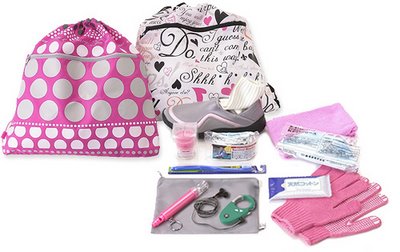
– as well as this rather sharp offering from Muji.
In the U.S., more time seems spent on the names of these kits than on their containers, so you're offered a double entendre-laden choice between the Triple Delight, the Family Royale, and the One Person Starter Disaster Fanny Pack.
But I leave you with two parting thoughts: first, the world’s "ONLY Armageddon Survival-Kit" is available here. It does not appear to contain duct tape – but it does "guarantee immortality." Second, cash spent on urban catastrophe preparation gear is never wasted: even if you're lucky enough not to have to use it, today’s kit is tomorrow’s collectible. Phil Boguch’s World War II survival kit, containing both silk stockings and chocolates, is now on display at the Mercer Island Museum of Flight; and a World War I M-592 Backpad-Style Survival Kit is valued at $1000 at Stan Wolcott’s Lucky Forward Militaria.
What could you possibly be waiting for?

Comments are moderated.
If it's not spam, it will appear here shortly!
actually a Paul Oakenfold cd would help if you need to signal an airplane or helocopter, you can sight through the spindle hole & signal with the mirror side in daylight
This is a topic that has begun to fascinate me to no end in the last year or so. It coexists nicely with my love of zombies.
One day I'm gonna go completely over the edge and spend $500 to buy a full fuck-off survival kit and keep it in a backpack next to my front door, just waiting for that day when I need to get out of Dodge damn quick...
I also blogged about survival a while ago, with some interesting links (like how to use a coke can and some chocolate to make fire...)
HI,
Mabye I'm blind and dyslexic but is there a matching list to go along with the numbered items in the picture with all the gear?
Post a Comment